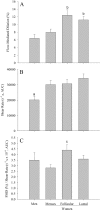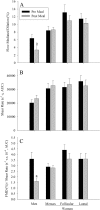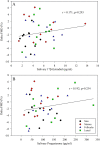Premenopausal women exhibit an inherent protection of endothelial function following a high-fat meal
- PMID: 22383760
- PMCID: PMC3343134
- DOI: 10.1177/1933719111418125
Premenopausal women exhibit an inherent protection of endothelial function following a high-fat meal
Abstract
Endogenous estrogens likely increase blood flow and subsequently shear stress but have also been associated with improved endothelial function and cardiovascular protection. In contrast, a high-fat meal is thought to reduce endothelial function and increase cardiovascular risk. Therefore, we tested the hypotheses that fluctuating hormones across the menstrual cycle (1) facilitate an increase in shear rate and explain phase-specific differences in flow-mediated dilation (FMD) and (2) provide vascular protection against the insult of a high-fat meal. Flow-mediated dilation was determined at baseline and 4 hours following a high-fat meal in young women during the menses (M), follicular (F), and luteal (L) phases of the menstrual cycle. Male control participants were studied once. 17β-Estradiol was elevated (P < .05) during the F (5.3 ± 0.7 pg/mL) and L (5.2 ± 0.6 pg/mL) phases when compared to the M (3.9 ± 0.5 pg/mL) phase, and this was accompanied by an elevated FMD in the F and L phases (12.4 ± 1.4% and 11.2 ± 0.9%, respectively) compared to M (8.0 ± 0.9) with no change in shear rate. Female postprandial FMD was similar throughout the menstrual cycle, while men exhibited a 50% reduction (6.4 ± 1 to 3.3 ± 1%; P < .05). Interestingly, the postprandial FMD response was not associated with concentrations of either 17β-estradiol or progesterone. Despite acutely changing ovarian hormones across the menstrual cycle, shear stress is invariant and therefore does not account for the changes in FMD. Additionally, young women appear to have an inherent vascular protection from the insult of a high-fat meal, perhaps helping to explain sex-specific differences in cardiovascular risk.
Conflict of interest statement
The authors declared no potential conflicts of interest with respect to the research, authorship, and/or publication of this article.
Figures




Similar articles
-
Brachial artery endothelial function is stable across a menstrual and oral contraceptive pill cycle but lower in premenopausal women than in age-matched men.Am J Physiol Heart Circ Physiol. 2018 Aug 1;315(2):H366-H374. doi: 10.1152/ajpheart.00102.2018. Epub 2018 May 4. Am J Physiol Heart Circ Physiol. 2018. PMID: 29727219
-
The impact of menstrual phase on brachial artery flow-mediated dilatation during handgrip exercise in healthy premenopausal women.Exp Physiol. 2018 Feb 1;103(2):291-302. doi: 10.1113/EP086311. Epub 2017 Dec 5. Exp Physiol. 2018. PMID: 29083061
-
The influence of acute hyperglycaemia on brachial artery flow-mediated dilatation in the early and late follicular phases of the menstrual cycle.Exp Physiol. 2019 Jun;104(6):957-966. doi: 10.1113/EP087536. Epub 2019 Apr 22. Exp Physiol. 2019. PMID: 30927376
-
Impact of the menstrual cycle on peripheral vascular function in premenopausal women: systematic review and meta-analysis.Am J Physiol Heart Circ Physiol. 2020 Dec 1;319(6):H1327-H1337. doi: 10.1152/ajpheart.00341.2020. Epub 2020 Oct 16. Am J Physiol Heart Circ Physiol. 2020. PMID: 33064553
-
Impact of meal fatty acid composition on postprandial lipaemia, vascular function and blood pressure in postmenopausal women.Nutr Res Rev. 2018 Dec;31(2):193-203. doi: 10.1017/S0954422418000033. Epub 2018 Mar 16. Nutr Res Rev. 2018. PMID: 29547370 Review.
Cited by
-
Differences in cardiovascular risk factors associated with sex and gender identity, but not gender expression, in young, healthy cisgender adults.Front Cardiovasc Med. 2024 Sep 5;11:1374765. doi: 10.3389/fcvm.2024.1374765. eCollection 2024. Front Cardiovasc Med. 2024. PMID: 39318832 Free PMC article.
-
Decline of popliteal artery flow-mediated dilation with aging and possible involvement of asymmetric dimethylarginine in healthy men.J Med Ultrason (2001). 2019 Oct;46(4):503-511. doi: 10.1007/s10396-019-00946-2. Epub 2019 Apr 23. J Med Ultrason (2001). 2019. PMID: 31011935 Free PMC article.
-
Endothelial Dysfunction in Cystic Fibrosis: Role of Oxidative Stress.Oxid Med Cell Longev. 2019 Jun 19;2019:1629638. doi: 10.1155/2019/1629638. eCollection 2019. Oxid Med Cell Longev. 2019. PMID: 31320980 Free PMC article.
-
The impact of repeated, local heating-induced increases in blood flow on lower limb endothelial function in young, healthy females.Eur J Appl Physiol. 2021 Nov;121(11):3017-3030. doi: 10.1007/s00421-021-04749-7. Epub 2021 Jul 12. Eur J Appl Physiol. 2021. PMID: 34251539
-
Does the Menstrual Phase Matter in Vascular Endothelial Responses to Acute Exercise? A Narrative Review of the Literature.Sports (Basel). 2025 Jun 27;13(7):210. doi: 10.3390/sports13070210. Sports (Basel). 2025. PMID: 40711095 Free PMC article. Review.
References
-
- Isles CG, Hole DJ, Hawthorne VM, Lever AF. Relation between coronary risk and coronary mortality in women of the Renfrew and Paisley survey: comparison with men. Lancet. 1992;339(8795):702–706 - PubMed
-
- Lerner DJ, Kannel WB. Patterns of coronary heart disease morbidity and mortality in the sexes: a 26-year follow-up of the Framingham population. Am Heart J. 1986;111(2):383–390 - PubMed
-
- Erzen B, Sabovic M, Sebestjen M, Poredos P. Endothelial dysfunction, intima-media thickness, ankle-brachial pressure index, and pulse pressure in young post-myocardial infarction patients with various expressions of classical risk factors. Heart Vessels. 2007;22(4):215–222 - PubMed
-
- Guerci B, Kearney-Schwartz A, Bohme P, Zannad F, Drouin P. Endothelial dysfunction and type 2 diabetes. Diabetes Metab. 2001;27(4 pt 1):425–434 - PubMed
Publication types
MeSH terms
Grants and funding
LinkOut - more resources
Full Text Sources

